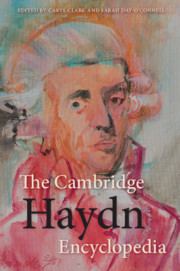'This is a fascinating, wide-ranging volume written by leading Haydn scholars from around the world. The simultaneously substantive and incisive essays, a pleasure to read as they enlighten at every turn, ably reflect and build on recent Haydn scholarship. In short, The Cambridge Haydn Encyclopedia is essential reading for all musicians - performers, listeners, scholars, critics - experienced and inexperienced alike, who want better to understand and appreciate Haydn and his remarkable musical achievements.'
Simon P. Keefe - J. R. Hoyle Chair in Music, University of Sheffield, and author of Mozart in Vienna: the Final Decade
'… this encyclopedia is replete with thoughtful information on the significance of Haydn to his times and on how aspects of his times - including the Enlightenment overall - impacted his development and production. Illustrations, including musical excerpts, are scattered throughout, with cross-references embedded in the narratives … Highly recommended.'
A. J. Adam
Source: Choice
'The Cambridge Haydn Encyclopedia has much of value and is eminently user-friendly …'
David Threasher
Source: Gramophone
'A paradise for 'dipping in' at random and seeing where the journey takes you.'
Malcolm Hayes
Source: BBC Music Magazine
'Four years in the making, this book is a significant and welcome addition to Haydn studies. By adopting the same ethos as the great encyclopaedists of the past, the editors have opened up some fresh areas of musical knowledge to modern readers. The best work from previous centuries is included, along with fresh topics related to our own times. So, while some entries, such as acoustics and counterpoint, are subjects that the reader would naturally expect to encounter, others - notably disability and gender - reflect the new research pathways that young scholars are choosing to follow today.'
Denis McCaldin
Source: Haydn Society Journal
'This major book is a treasure trove, a cabinet of wonders … a Wiki-Haydn … in an inspired touch, short entries, ranging in length from two to five pages, are punctuated by seven much longer ‘conceptual essays’, like pillars in a temple, which both tie together a cluster of other entries and fly their own kites … We can be grateful to Clark and Day-O’Connell for assembling such a rich and stimulating, if necessarily pointillist, portrait of this joyful composer.'
Michael Spitzer
Source: Eighteenth-Century Music



